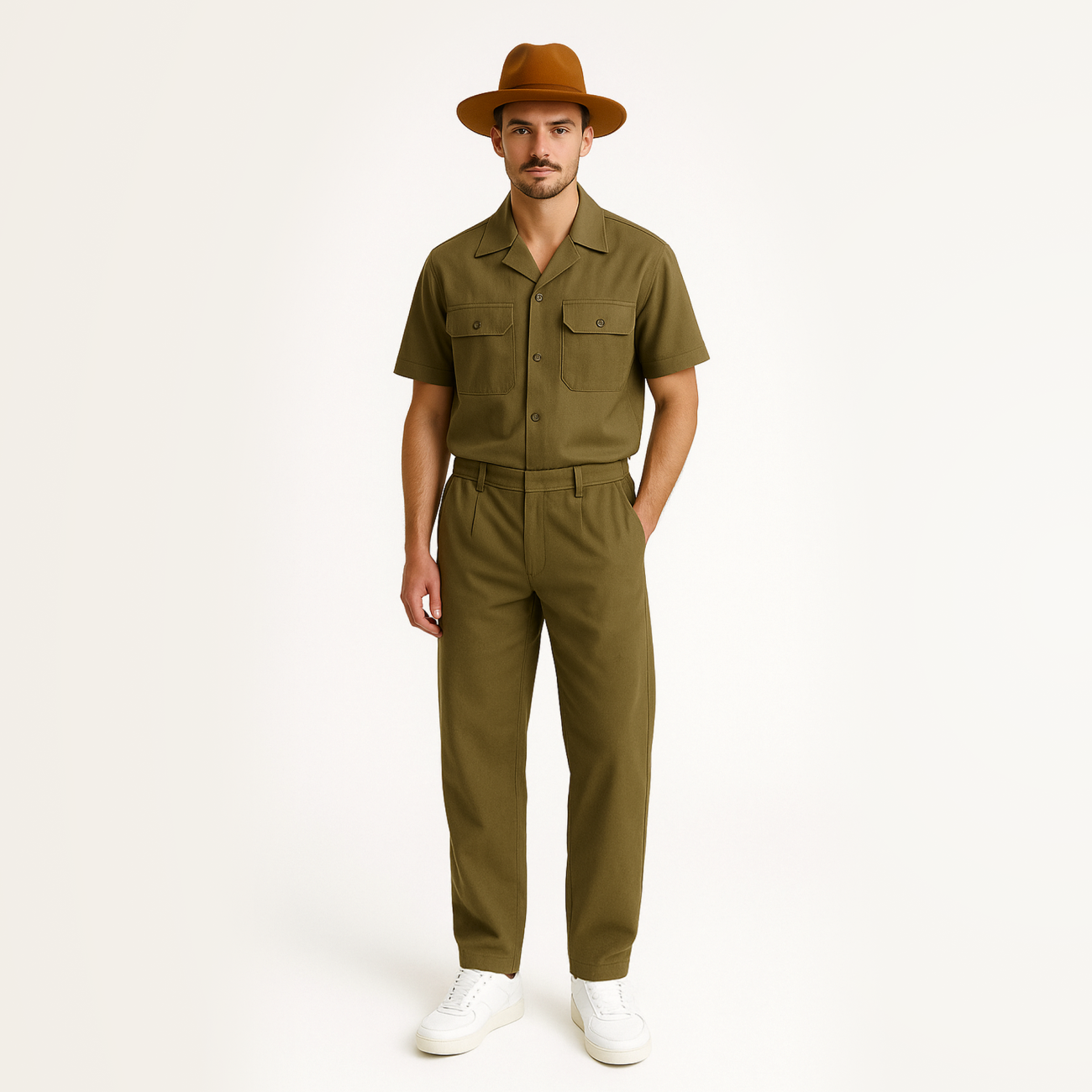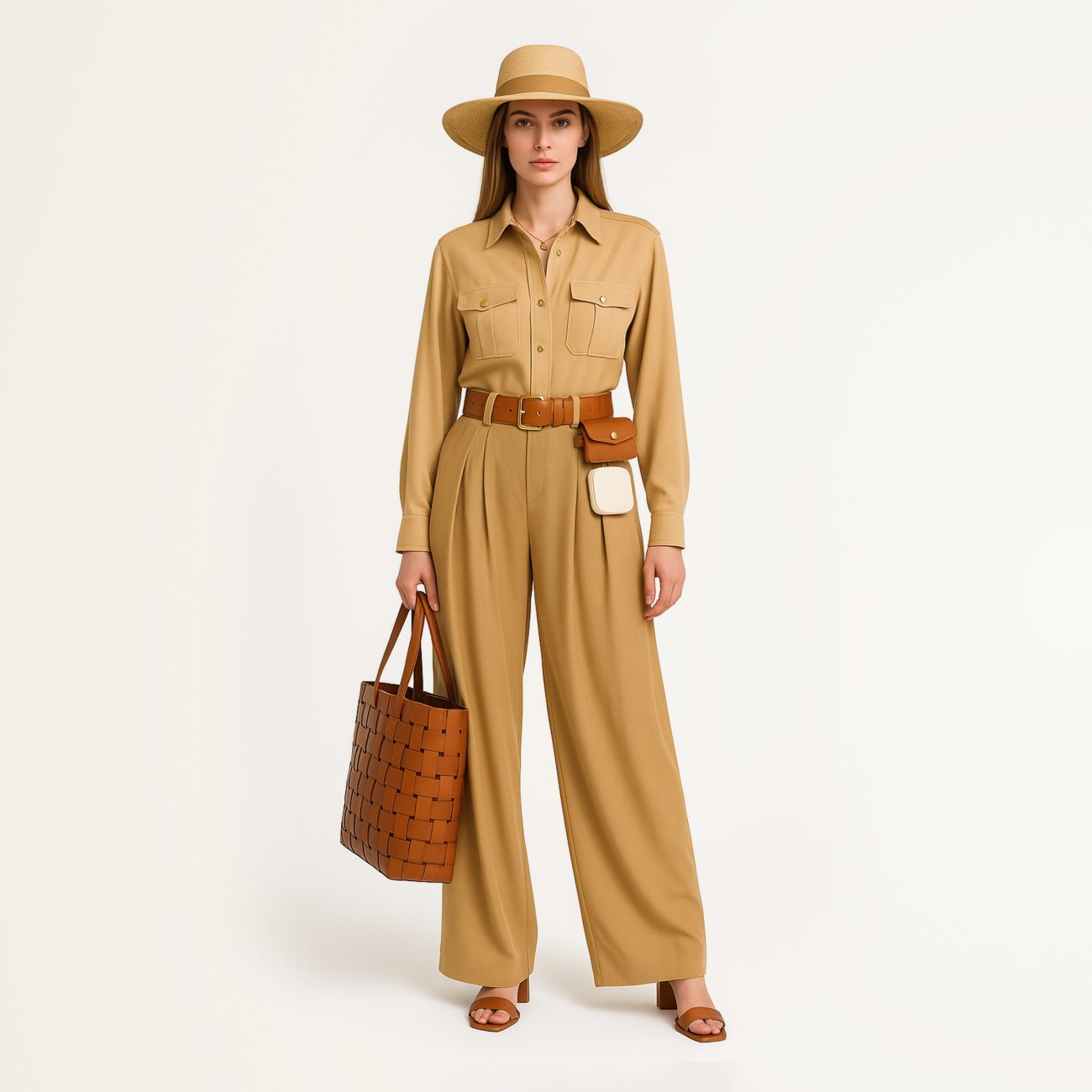Safari
Safari style is an aesthetic that blends practicality with refinement. Its philosophy is built on the idea of combining functionality with a sense of adventure, freedom, and connection with nature. This style carries the spirit of exploration and the pursuit of harmony with the natural world.
History
The history of safari style dates back to the colonial era of the 19th century, when European explorers, soldiers, and colonizers sought to adapt to the harsh climate conditions of Africa and India. At the time, clothing was a matter of necessity: in order to cope with high temperatures and humidity, lightweight and breathable fabrics such as cotton and linen were used, and garments were designed to offer comfort in extreme climates. The main goals were both survival and camouflage — shades of khaki, beige, and sand were ideal for blending in with nature and remaining unnoticed.\n\nInitially utilitarian, the style evolved in the early 20th century into a symbol of the exotic traveler. The British Army developed uniforms with jackets and trousers that allowed freedom of movement and provided protection from the sun. These uniforms, with their patch pockets, wide belts, and relaxed cuts, were later adopted by hunters and tourists. At that time, the safari look was associated with adventurers and explorers who left the civilized world behind to delve into the unknown. This added a sense of romance and mystery to their image — something that soon caught the attention of the fashion world.\n\nSafari style entered mainstream culture largely thanks to cinema. Films from the 1930s, such as Tarzan and other adventure movies, helped solidify the image of the fearless explorer dressed in neutral-colored clothing, with signature pockets and belts. This image became an almost obligatory attribute of the adventurous hero and immortalized the safari style. Later, Hollywood embraced safari aesthetics in classic films like The African Queen and Mogambo, where characters such as expedition scientists and adventurers embodied the romanticism and thrill of African landscapes.\n\nThe true turning point came in 1967, when Yves Saint Laurent introduced his safari-inspired collection. His interpretation included structured jackets, shirt dresses, and shorts in neutral tones, enhanced with elegant details like leather belts and statement pockets. Saint Laurent was inspired by expeditions and African art, skillfully adapting the explorer aesthetic for a female audience and elevating the style with sophistication and polish.\n\nThis collection caused a sensation and established safari style as a symbol of refined fashion. Thanks to Saint Laurent, safari moved from the realm of utilitarian and adventurous clothing into haute couture, becoming a staple not only for men but also for women. The emergence of tailored women's safari suits in neutral tones was revolutionary, solidifying its place as a style that could transition seamlessly between urban and natural settings.\n\nSince then, safari style has been reinterpreted many times by leading designers such as Ralph Lauren, Donna Karan, Michael Kors, and Chloé, each adding new elements and adapting it for a modern audience. In the 1980s and 1990s, the style became a symbol of luxury — one that highlighted an interest in travel and an active lifestyle.
Signature elements of the style
Color palette
The safari style primarily features natural, muted tones: sand, khaki, beige, olive, terracotta, and shades of brown. These colors reflect the natural surroundings, emphasizing harmony with nature and creating a soft, understated look.
Prints
The main print associated with this style is camouflage, though its use is limited and typically seen in bolder interpretations. Animal prints (such as zebra or leopard) may also be incorporated but in moderation, to maintain sophistication.
Textures
Safari fabrics are lightweight, durable, and natural: linen, cotton, wool, and occasionally leather. These materials are breathable and offer protection from the sun, making them ideal for both travel and urban life. Leather or suede elements are sometimes used in accessories.
Cuts & silhouette
The cut is clean and functional. Jackets and shirts are generally straight or slightly fitted, with large pockets and belts to accentuate the waist. Shorts and trousers are usually loose to allow for maximum comfort and freedom of movement.
Details: wide leather belts or cord belts, patch pockets, decorative distressing, turn-ups.
Wardrobe essentials
- Safari Jacket or Blazer: Arguably the key piece. This type of jacket often features large patch pockets and a belt at the waist.
- Trousers and Shorts: Straight-cut, in neutral shades, made from lightweight fabrics.
- Shirts: Classic long-sleeve shirts with pockets, versatile enough to be worn alone or layered.
- Skirts and Dresses: Shirt dresses or straight-cut skirts that are both practical and comfortable.
- Accessories: Wide-brimmed hats, leather belts, classic-style sunglasses, practical strap sandals, and boots.
Substyles
Email: support@belt-app.com


















